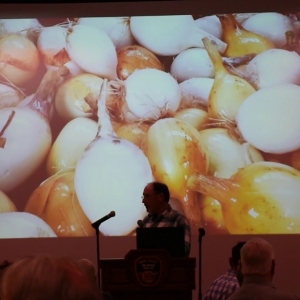Other Ag News: USDA Staffing Crisis: Eroding Capacity Within the Foreign Agricultural Service
“I believe public service is my calling… The Foreign Agricultural Service (FAS) hasn’t received much coverage in the media, but they do important work in advancing American agricultural interests abroad. Given the current administration’s priorities, I thought they would double down on this mission by staffing departments like the FAS. However, despite receiving and signing an offer letter following an arduous interview and security clearance process, my offer was withdrawn before my start date.”
— Rescinded FAS hire
The Foreign Agricultural Service (FAS) is the branch of the United States Department of Agriculture (USDA) responsible for building international markets for US agricultural products and overseeing international trade negotiations. It is also the division responsible for supporting international food aid programs, producing detailed reports on international market conditions, and helping to ensure food safety for global agricultural markets. In a time of great economic uncertainty and the impacts of trade wars, the role of the FAS is more important than ever, but their staff has been gutted.
Although NSAC’s primary attention is on domestic programs that serve farmers and rural communities, the staffing losses at the FAS reveal the same systemic problem affecting every corner of USDA: the erosion of public-sector capacity. The loss of highly trained staff at FAS reflects the same hollowing-out of USDA expertise that threatens the agency’s ability to serve farmers, rural communities, and sustainable food systems.
On July 24, 2025, US Secretary of Agriculture Brooke Rollins released memorandum SM-1078-015 announcing a proposed reorganization of the US Department of Agriculture (USDA). Created without consultation from farmers or other stakeholders, the restructuring plan follows a loss of more than 20,000 employees since the start of 2025 and creates the potential for thousands more additional staff to leave. After widespread outcry, the USDA opened an ad hoc opportunity for comment via email but failed to issue a formal Federal Register notice. The ad hoc comment period ended on September 30, 2025. NSAC continues to urge the USDA to make all submitted comments publicly available and to provide meaningful and transparent opportunities for stakeholder feedback to be addressed and incorporated. NSAC’s comment on the reorganization can be seen here.
This post is the fifth installment in our series examining USDA’s staffing crisis and the effects of the proposed reorganization of the USDA. Previous posts discuss overall losses, the devastation of research agencies, the Natural Resources Conservation Service, and the Farm Service Agency. In this post we discuss the loss of staff in the FAS and how it affects the farmers and communities who depend on a well-functioning USDA, whether for technical assistance, fair trade relationships, or access to reliable market information.
FAS Faces Steep Staff DeclinesThe last decade has seen a steady decline in FAS staffing levels and the agency was hit hard this year by staff losses from the Deferred Resignation Program (DRP) and recent staff separations. Staffing levels at FAS peaked at just under 1,000 employees in 2010 before falling 25% to approximately 739 employees in September 2024, according to data from the Office of Personnel Management (OPM).
Figure 1: FAS Staffing Levels
Data from Office of Personnel ManagementSince January 2025, the FAS has lost an additional 19% of their staff from the already depleted numbers. The DRP was a program that offered federal staff incentives to voluntarily resign from their positions as an effort to reduce staff numbers. Overall, approximately 15,173 USDA staff left their positions through the DRP.
FAS lost 15 staff members in the first round of DRP resignations in February 2025 and another 89 employees in the second round of DRP. In addition to the 104 staff members who left via the DRP, FAS also lost 40 more employees to other separations between January and March 2025, according to OPM. Separations can include quitting, retirement, firing, transferring to another agency, or other separation from the agency. This brings the FAS staffing levels to their lowest level in over twenty years, nearly 40% lower than their peak in 2010.
Eroding Institutional Knowledge and MentorshipAs seen in other USDA agencies, many of the staff losses at FAS were highly skilled and experienced employees. Employees who separated from FAS between January and March 2025 had an average of 26 years of service, according to data from OPM. These were highly experienced and specialized professionals with valuable institutional knowledge that supported the agency.
A senior staff member who left the agency via the DRP spoke of feeling pushed out before she was ready due to the uncertainty of her role’s future and the future of the agency:
“I didn’t plan to retire. I was planning to stay at least three more years…{but} the more I thought about it the more I realized I was coming to work extremely tense and more and more stressed out everyday and I didn’t want to do that. I came to this job because I love the work and believe in the work,” but she felt she couldn’t stay amidst an uncertain future.
This senior member’s departure exemplifies the widespread impacts of losing experienced staff. She led a USDA-wide career coaching program to help public servants grow their career, provided a leadership course for midcareer foreign service officers, and mentored many younger staff. “I was trying to create leaders to be the change that we want to see. Authentic and communicative leaders for the future of the agency.” All of this mentorship and knowledge is lost when career employees leave or are forced out of the USDA. These losses and the institutional knowledge accompanying them are not easily reversible, and the reorganization of the USDA threatens to further exacerbate existing losses.
Reorganization Risks Deepening the CrisisThe loss of staff and institutional knowledge at FAS is emblematic of the broader hollowing out of USDA capacity. Staff losses contribute to low staff morale and declining ability to serve US farmers and stakeholders, and the reorganization drafted without stakeholder input will greatly exacerbate these losses. Unlike many other USDA agencies, FAS employees are overwhelmingly located in Washington, DC and surrounding areas (615 of the 739 employees in September 2024), with the remaining serving to represent US interests in foreign countries. The reorganization’s vague plans to move staff out of the DC region would be particularly disruptive to this agency that depends on interfacing closely with staff on the Hill and with other federal agencies outside of the USDA regarding international trade.
The future of the FAS, as with every other USDA agency, is uncertain as the administration advances a reorganization plan without transparency and without meaningful input from farmers and stakeholders. Without decisive action to restore USDA’s workforce, the loss of institutional knowledge and public service capacity will continue to weaken the foundation of US agriculture.
The post USDA Staffing Crisis: Eroding Capacity Within the Foreign Agricultural Service appeared first on National Sustainable Agriculture Coalition.
Signup for the Ag Newsletter
Get the freshest farm news, events and updates from in and around Cattaraugus County, NY at least once a month! Go signup!
Other ways to stay connected:
Get Involved in Farming
Resources for Starting a Farm in Cattaraugus County
Profile of Cattaraugus County soils
Agriculture Career Exploration
Questions about farming? Find out Who to Call










